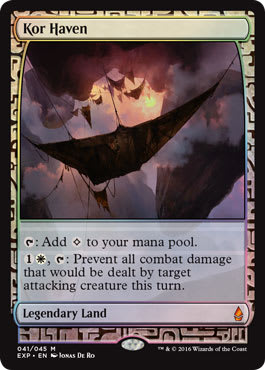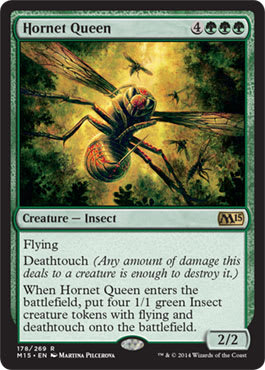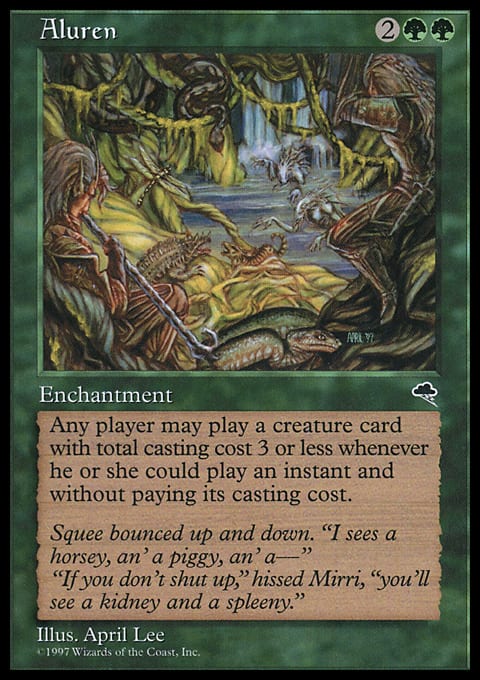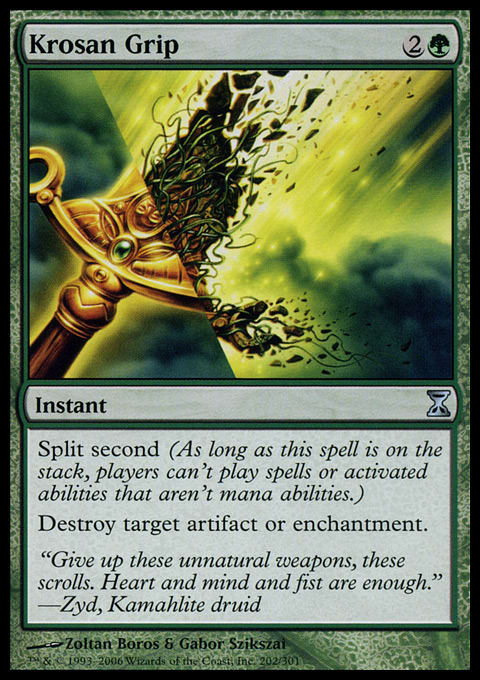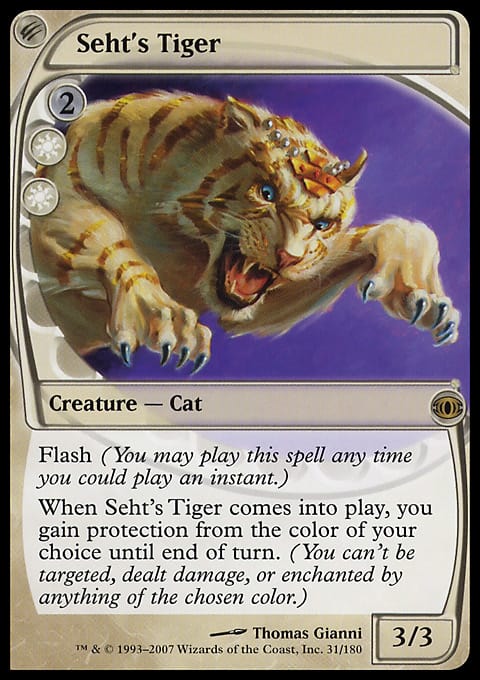Are you playing Commander this week? Are you shuffling up some multiplayer for the masses? Are you planning on loading up Magic Online for some multiplayer fun?
Want to learn some tips about how to win? Sure, you are playing Magic to have fun. We all are! But you are playing a game to have fun, not working on pottery or knitting. Games are about trying to win.
So let’s win this thing!
I have listed ten major tips and strategies for winning multiplayer games below. I’ve collected a ton of major tips through the years. Some are pretty minor, and some are pretty significant, but all will help you get that win.
Here they are!
10 — Play Noncreature Defense
People don’t always make perfect decisions in multiplayer like they do in tournaments. The more permanents you control, the more likely someone is to skip you and head somewhere else. It’s not uncommon to see a player who has four or five ground creatures be skipped by a foe looking for an attack of opportunity with his or her flyer—since surely one of them has flying, or reach, or something. The attacker will go after a player with a tapped flyer, or good noncreature defense like Maze of Ith or something instead. The board is not always read, and people can’t always keep track of every card on the field. No one plays Magic to do math—people do it to hang out, play games, and have fun. Multiplayer Magic is particularly suited to that ignorance-is-bliss style of play. So run stuff that’s defensive but doesn’t look like it, such as Kor Haven or No Mercy. Also . . .
9 — Density of Creatures
The more creatures you run, the more dangerous you look. A player with one or two large threats often looks more vulnerable than the guy with four or five utility creatures. Since people aren’t always looking around the board perfectly, use that to your advantage by having a high density of creatures. The more creatures it appears you have, the more likely folks are to skip you altogether and move on. (As a side note, I’d always recommend using those cards that resemble tokens rather than dice or something—it adds to your visual threat level.)
8 — Drop Your Threat Radar
Some players can’t help it. Ever see a Commander player who’s running every single potent card in the format? From Mind's Eye and Rhystic Study through the best Equipment, Consecrated Sphinx, Duplicant, and more, all of the biggest, threatiest, and powerful stuff is in that deck. And then that person loses with his or her good stuff. Why? Because people are inclined to shut it down. Hey, look, if Brad has Mind's Eye and a nasty deck, and I’m running Treasure Trove, which is more likely to be targeted by Sarah’s Dismantling Blow? If my foe has Deadeye Navigator and I have Nephalia Smuggler, which is more likely to be Murdered? There’s something to be said for dropping your threat level and keeping your DEFCON score at 5. As a side note . . .
7 — Don’t Appear to Be Comboing
I often run cards that are typically seen in combo decks in noncombo ways. For example, I added the banned-in-Commander Painter's Servant to a Llawan, Cephalid Empress deck I built for the format. The Servant is banned for interactions with Grindstone and Iona, Shield of Emeria, not for comboing with Llawan to bounce stuff en masse (and is vulnerable to either creature or artifact removal). I’ll run the aforementioned Navigator with lower-level cards and such. I’m not breaking them. So I have a bit of a reputation at my table for not usually running powerhouse combos to win immediately. If that’s not your rep, I’d recommend steering clear of those cards outside of a dedicated combo deck. If people see Kobolds of Kher Keep or Aluren and they suspect combo, steer clear of them. You don’t want folks to mistake your fun stuff for a game ending combo. And . . .
6 — If You Are Comboing Out, Don’t Appear to Be
If you are trying to combo win, don’t reveal it until too late. The best way to win at a multiplayer table with a combo deck is to not appear to be a combo deck. There are a ton of classic combo cards that folks know about from the history of Magic. So don’t run a combo around an engine like Enduring Renewal. It signals, “COMBO! COMBO! COMBO!” in bright, red lights for everyone to see. Don’t use that as your engine. Instead, use cards that work to win the game but that may not, at first, seem to be combos. Or, if you must, have normal cards, and then drop the one engine card and go off. Take a card like Warstorm Surge. It’s expensive, and it’s run in a lot of decks with creatures that have a high power to shoot stuff and people. You can play that as a combo element without generating a lot of heat. This will be especially true if the support were similar to what you might normally suspect for this deck (big creatures, mana Elves, etc.). Then, you toss out a combo, like Saproling Burst, and you can deal 21 damage. That’ll probably kill someone. (You are dealing it in amounts of 6, 5, 4, 3, 2, and 1, so you can spread it out to shoot creatures or multiple players.) Here’s a quick shell that comes to mind:
Surges and Bursts ? Casual | Abe Sargent
- Creatures (18)
- 2 Horned Kavu
- 2 Keldon Vandals
- 2 Quirion Elves
- 2 Sparkcaster
- 2 Wild Celebrants
- 4 Conclave Naturalists
- 4 Skyshroud Elf
- Spells (16)
- 2 Fireball
- 2 Rolling Thunder
- 4 Cultivate
- 4 Saproling Burst
- 4 Warstorm Surge
- Lands (26)
- 11 Forest
- 11 Mountain
- 4 Gruul Turf
And there you are. Everything looks fine, with high-powered cards like Keldon Vandals synergizing with the Surge. Then, you drop the Burst and kill someone, and you still have the Surge for more beats. Shoot, even the Sparkcaster ad Horned Kavu look more to be awesome ways to reload your various creatures with triggers (like Wild Celebrants) than they do combo cards—until you drop the Surge and then play and replay these creatures as long as you have mana and targets.
That’s not the only way to push this concept either. Consider that a Verdant Succession deck could have a lot of innocent cards, such as Ravenous Baloth and Sakura-Tribe Elder. Then you drop it, sacrifice a bunch, and go off that turn. If you intend to combo off, don’t appear to have that plan.
5 — Don’t Get Angry
Sometimes, players in Casual Land take losses personally. We’ve all seen players who become angry, take it personally, and more. Someone will grab some tournament deck designed for a quick kill, shuffle it, kill his or her target in five turns, die the next one, and think he or she somehow did the Magic world a service. Folks, don’t do this. Let’s all make a deal. Don’t choose targets for personal, rather than game, reasons. And don’t become upset and take it personally when someone chooses to come your way for game reasons. Different players assess the game different, and that’s okay. And table talk is fine. But at the end, if I attack you because of something I deem a threat, or because I want to finish this, knock it off. And then people won’t come after you for personal reasons and retributions, and you’ll more likely win.
4 — Cards-in-Hand Count
One of the most important resources in Magic is your hand. The more cards you have in your hand, the more options you have and the more hidden knowledge you have. The cards in someone’s hand are a vital resource, and don’t forget them. Don’t let a player play an occasional card to keep seven in the grip and then just build the perfect hand for when needed. Fight that person. Push that person, and force him or her to drop some cards. Make that player play the game. Cards in the hand are very important to figuring out who the threat is. I don’t mind swinging at the player with a better defense but with double the number of cards in hand. I may Dismantling Blow the worse Sensei's Divining Top when the controller taps it to put it back—that player has a ton of cards—over the more powerful Sylvan Library or Land Tax of someone else. Hands count. And similarly . . .
3 — Don’t Forget Card Advantage
Magic is sensitive to card advantage, and multiplayer even more so. Don’t forget about it. Most people remember to focus on cards like Mulldrifter or Tidings or Damnable Pact. But don’t forget to have it affect your play. Don’t forget to grab Pit Keeper. (Wait, what?)
I was playing a game online a few years ago, in a format that doesn’t exist anymore (Pauper—only commons—Singleton—no more than one of any card—Prismatic—two hundred fifty cards minimum and twenty of each color). It was awesome and one of my favorite formats of all time. I have a major beater, and my opponent is under the clock and top-decks Dimir Infiltrator. He has a Terminate in his deck it can transmute for to fetch, and he then use to kill my big beater. That’s what we’d all do, right? Nope! He transmutes the Infiltrator and finds Pit Keeper. He plays it, returns the Infiltrator, and then transmutes it again, grabs the Terminate, and kills my guy. The result is a dead creature on my side and a 2/1 Pit Keeper on his. When we play, we often forget to grab the Pit Keeper first because we are so focused on the answer to the problem. Card advantage is not just a few cards here and there, but a constant question and push. Grab the Pit Keeper.
2 — Flexibility Wins
The above example also shows how a flexible deck is more suited to winning. By having transmute cads, with a variety of options, the likelihood to have the best answer or problem for a given situation is enhanced. Going into multiple colors or more mana often gives you a better, more flexible card, and it’s worth it. Take a removal spell like Naturalize. It costs 2 mana, nice and simple. Now, if you go to 3 mana, you can have Krosan Grip. Black can go from Murder to Utter End. Blue can go from Cancel or Counterspell to Dismiss and Hinder and Forbid. You can find better creatures as well. In multiplayer, a flexible creature like Karmic Guide is usually going to trump a pure beater of the same cost, like Baneslayer Angel. Figuring out how to win is a puzzle, and flexibility is a cheat sheet.
1 — Stay Alive
It’s more important to not die than it is to kill someone. If you have five people at the time, don’t risk death to kill one. Don’t bring yourself to the end of things to slay a person. Don’t expose yourself needlessly. It’s also hard to predict what threats could look like. For example, you could swing at someone, leaving yourself open to counterattacks, but no one is controlling any creatures you care about. So you bring the heat. Totally understandable. Then, you are surprised by someone dropping a creature with haste and swinging at you. Oh noes! Have a Fog effect. Make some tokens instantly. Drop a creature with flash. Tap your Urza's Factory to make a 3/3 to block. Play a spell to untap your forces, like To Arms! and hit folks. Similarly, run some ways to keep yourself from death to an X spell or a devastating Mind Shatter that comes your way. I like cards like Seht's Tiger and Ivory Mask to help out here. You can’t win until you don’t die. So don’t die.
This doesn’t mean you have to have some obtuse pillow-fort strategy with Ghostly Prison, Propaganda, Ivory Mask, and Web of Inertia. There are ways to slide in stay-alive ideas without it. Here, I’ll you a quick and dirty example, using a deck concept mentioned above:
Verdant Victory ? Casual | Abe Sargent
- Creatures (34)
- 2 Deadwood Treefolk
- 2 Splinterfright
- 2 Starved Rusalka
- 4 Caustic Caterpillar
- 4 Gobbling Ooze
- 4 Llanowar Elves
- 4 Ravenous Baloth
- 4 Sakura-Tribe Elder
- 4 Spore Frog
- 4 Yavimaya Elder
- Spells (4)
- 4 Verdant Succession
- Lands (24)
- 24 Forest
Verdant Succession triggers when a creature of the green persuasion dies, and you can search and fetch another copy straight to the battlefield. Ideally, you run it with some sacrifice effects (like Phyrexian Altar or Blasting Station). You can also run some sacrifice cards as well, so you an sacrifice Ravenous Baloth for 4 life and another Baloth. You can win with a big ol‘ stocked graveyard, a card like Splinterfright leading the charge, or your various triggers. I have a couple of sacrifice cards, too. Now, once someone knows what you’re doing, or you expose yourself, you can lean on Spore Frog. Sacrifice to prevent combat damage, and if you have a Succession out, you can tutor up another one right into play. It suits the deck perfectly, and it gives you a brake in case foes start looking your way.
And there you are! Get ready to push your multiplaying skills to the next level. What did you think? Anything here that really speaks to you as a multiplayer? And as always, thanks for reading!













